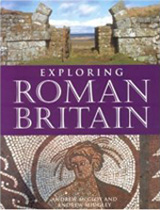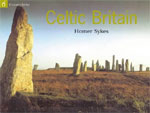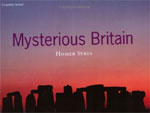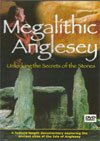Web Resources (Alphabetical by Title)
 CADW CADW
Cadw is the Welsh Government's historic environment service working for an accessible and well-protected historic environment for Wales. According to its website, "We conserve Walesís heritage. We help people understand and care about their history. We help sustain the distinctive character of Wales." Cadw is a Welsh word meaning "to keep" or "to protect."
 The Megalithic Portal The Megalithic Portal
"Over the years," according to website creator Andy Burnham, "the project has become a major team effort with input from scores of photographers, archaeologists, locals and visitors...An overriding reason to do this is that many of these ancient sites are not protected in any way, and many have disappeared over the last 50 years or so under development and intensive agriculture. Even sites that are scheduled have limited real protection, so our mission is to document, publicise and protect these remaining sites."
 Megalithics Megalithics
An archive of over 5000 photos of stone circles and other megalithic monuments in the British Isles, Ireland, and Europe. Portal Dolmens, Recumbent Stone Circles, Cup and Ring Carvings, Long Barrows, Cairns, Passage Graves, Wedge Tombs, etc. Most sites have full spherical VR panoramas and infrared photography, plus ten figure map references measured on site with a GPS unit.
 Stone Pages Stone Pages
Stone circles, dolmens, ancient standing stones, cairns, barrows, hillforts and archaeology of megalithic Europe with special pages on Scotland, England, Ireland, and Wales, among others. Created in 1996 by Paola Arosio & Diego Meozzi, the site has grown to over 4,000 pages. The authors live in Trevignano Romano, north of Rome, Italy.
 Wikipedia Wikipedia
Wikipedia -- from wiki (a type of collaborative website) and encyclopedia -- is a multilingual, web-based, free content encyclopedia project written collaboratively by volunteers that currently ranks among the top ten most-visited websites worldwide.The vast majority of its articles can be edited by anyone with access to the Internet. Contains several hundred useful pages on specific saints, holy sites, churches, monasteries, abbeys, among others, which are most useful to this website.
Print Resources (Alphabetical by Author)
 Janet and Colin Bord Janet and Colin Bord
Photography by Jason Hawkes
Prehistoric Britain from the Air
Wigston, Leicestershire: Silverdale Books, 2004
The book is divided into three main sections, England, Scotland and Wales and covers hillforts, standing stones, stone circles, henges, hillfigures, burial chambers, man made caves, ancient villages, huts and long barrows. The informative narrative provided about each site investigates myths and legends associated with the sites and this is interwoven with the archaeological evidence providing an account of how each site was used and some insight into the ancient patterns of life associated with the sites.
 Dave Hamilton Dave Hamilton
Mysterious Britain
Bath: Wild Things Publishing, 2020
Wild ruins B.C. reveals Britainís extraordinary ancient history, from 10,000 years ago to the birth of Christ. Exploring Britainís finest wild sites, discover the lost remains and mysterious stones that lie hidden in some of the most beautiful landscapes of Britain. From sacred tombs and caves, to awe-inspiring stone circles and earthworks, Bronze Age brochs to dramatic Iron Age hillforts. Most valuable for the visitor are his elaborate instructions on how to get to the sites
 CADW (David Longley and M. J. Yates) CADW (David Longley and M. J. Yates)
Anglesey: A Guide to Ancient Monuments on the Isle of Anglesey
Cardiff, Wales: CADW, 2001 (3rd Ed.)
After an archaeological and historical background of the periods of history on Anglesey, this guidebook offers three tours of the Isle of Anglesey. Tour 1 covers "saints and stones" in Eastern Anglesey. Tour 2 covers "saints and stones" in Western Anglesey. Tour 3 covers "saints and stones" on Holyhead.
 Andrew McCloy and Andrew Midgley Andrew McCloy and Andrew Midgley
Exploring Roman Britain
London: New Holland Publishers, 2006
Author Andrew McCloy selects 15 walks designed to encompass some of Britain's most distinctive Roman landscapes. With photographs by Andrew Midgley, this work offers insights into Roman culture and innovations and celebrates the enduring legacy of the Roman Empire in England, Wales, and Scotland. Sections include Roman Roads, Roman Towns, Roman Buildings, and Roman Fortifiucations and Military Bases.
 Chris Scarre Chris Scarre
The Megalithic Monuments of Britain and Ireland
London: Thames & Hudson, 2007
From a Professor of Prehistory at the University of Durham and a specialist in the prehistory of Western Europe, this work offers an examination of some of the most varied megalithic monuments in Europe that are found in the Britain and Ireland organized by geographical area. From the Neolithic Age and the arrival of pottery and farming some 6,000 years ago to the beginning of the Bronze Age, people used megaliths, earth, and wood to build grandiose monuments. The number and sheer diversity of these structures is astonishing, from massive stone rows and circles to barrows, chambered tombs, and earthwork enclosures. Henges and cursus monuments, which often lacked stone elements, also belong to the same general category of monumental prehistoric architecture.
 Rupert Soskin Rupert Soskin
Standing with Stones:
A Photographic Journey through Megalithic Britain and Ireland
New York: Thames & Hudson, 2009
From the southernmost tip of Cornwall to the far Scottish isles, a wonderful variety of ancient stone monuments still exists in Britain and Ireland, and this book guides the reader to over one hundred of them. Some megalithic sites, like Stonhenge and Newgrange, are well researched and often visited, while others, such as Fernworthy and Bleasdale, are barely known. From stone circles and henges to long barrows and cairns, our distant ancestors adapted and shaped their monuments to all environments, leaving us the tantalizing signs of their long-forgotten lives.
 Homer Sykes Homer Sykes
Celtic Britain
London: Cassell Paperbacks, 2001
Journey into mysterious Celtic landscapes, and view the fascinating artifacts they bequeathed us. Over 120 photographs take you from Cornwall, through England and Wales, and up to Scotland. Visit little-known locations from pre-Celtic times, ruined cells where holy men performed Christian ceremonies during the Dark Ages, and enigmatic sites such as Stonehenge, Avebury, and places shrouded in Arthurian legend. A powerful narrative reveals the historical and archeological evidence surrounding Celtic myths, folktales, saints, and more.
 Homer Sykes Homer Sykes
Mysterious Britain
London: Weidenfeld and Nicolson, 1995
Throughout Britain's length and breadth, ancient tribes, druids, Celtic saints, medieval knights, and 18th-century landowners have bestowed upon future generations a wealth of astonishing sights, structures, and landmarks. These awesome sights appear in evocative color photographs, richly enhanced with the history, legends, and folktales that surround them.
 John Watney John Watney
Celtic Wales
Andover, Hampshire: Pitkin Guides, n.d.
This small pamphlet is a tour of Wales from its beginnings from the Bronze Age and the arrival of the Celts to the "Age of the Saints" from the 6th-12th centuries. It also covers subjects such as Celtic life, the Druids, early and late Celtic art, hillforts and warriors, the Roman conquest and after, and literature and language. An appendix lists the sites discussed.
 Peter N. Williams Peter N. Williams
The Sacred Places of Wales: A Modern Pilgrimage
Bloomington, Indiana: 1st Books Library, 2001
This small book takes one on a journey around Wales, from Tintern Abbey in the southeast to the shrine of St. Winifred in Holywell in the northeast. It covers many of the ancient burial grounds, but is mainly centered on the six cathedrals of Wales: St. Woolos, Llandaff, Brecon, St. David's, Bangor, and St. Asaph.
Other Resources: DVDs
Megalithic Anglesey: Unlocking the Secrets of the Stones
DVD
 For thousands of years enigmatic standing stones and ancient burial mounds have dotted the landscape of the Isle of Anglesey in North Wales. Megalithic Anglesey is the first film to tell their stories, to go deep inside them with the modern interpreters and to bring to life the words of earlier explorers. The film follows a team of the most renowned archaeologists in this field as they explore and explain these fascinating places. Discover the ancient rock art of Barclodiad y Gawres and Bryn Celli Ddu, the stark grandeur of Trefignath, and the mysterious twin stones of Penrhos Feilw on Holy Island, and also explores the islands other best known sites as well as many of its lesser known ones. For thousands of years enigmatic standing stones and ancient burial mounds have dotted the landscape of the Isle of Anglesey in North Wales. Megalithic Anglesey is the first film to tell their stories, to go deep inside them with the modern interpreters and to bring to life the words of earlier explorers. The film follows a team of the most renowned archaeologists in this field as they explore and explain these fascinating places. Discover the ancient rock art of Barclodiad y Gawres and Bryn Celli Ddu, the stark grandeur of Trefignath, and the mysterious twin stones of Penrhos Feilw on Holy Island, and also explores the islands other best known sites as well as many of its lesser known ones.
Standing with Stones
DVD
 There are about 1,000 stone circles in the U.K. and Ireland. If you include other megalithic monuments such as stone rows, long barrows, cairns, cists, standing stones and others, the number runs to tens of thousands. Yet most people can only name one. This DVD is an exploration beyond Stonehenge, a discovery of the wealth that is Megalithic Britain. More than two years in the making, this film, written and presented by explorer and naturalist Rupert Soskin and produced and directed by Michael Bott, takes you from the tip of Cornwall to Wales, Ireland, the Isle of Man, and Scotland as far as the Outer Hebrides and Orkney on an unforgettable journey through the landscape of the ancient past. There are about 1,000 stone circles in the U.K. and Ireland. If you include other megalithic monuments such as stone rows, long barrows, cairns, cists, standing stones and others, the number runs to tens of thousands. Yet most people can only name one. This DVD is an exploration beyond Stonehenge, a discovery of the wealth that is Megalithic Britain. More than two years in the making, this film, written and presented by explorer and naturalist Rupert Soskin and produced and directed by Michael Bott, takes you from the tip of Cornwall to Wales, Ireland, the Isle of Man, and Scotland as far as the Outer Hebrides and Orkney on an unforgettable journey through the landscape of the ancient past.
A History of Ancient Britain
DVD
 Historian and archaeologist Neil Oliver travels the British Isles to tell the story of the very beginnings of the land and its people. The series traces the development of Britain, from the glacial wasteland of 12,000 BC, through the glories of the Stone Age to the magnificence of international Bronze Age society Ė following the growth of farming and trade; the establishment of homes and hamlets and the sophisticated spiritual life of the country, including the incredible creation of the monument at Stonehenge. The four parts are: Episode 1: Age of Ice; Episode 2: Age of Ancestors; Episode 3: Age of Cosmology; Episode 4: Age of Bronze. Originally broadcast on BBC in 2011. Historian and archaeologist Neil Oliver travels the British Isles to tell the story of the very beginnings of the land and its people. The series traces the development of Britain, from the glacial wasteland of 12,000 BC, through the glories of the Stone Age to the magnificence of international Bronze Age society Ė following the growth of farming and trade; the establishment of homes and hamlets and the sophisticated spiritual life of the country, including the incredible creation of the monument at Stonehenge. The four parts are: Episode 1: Age of Ice; Episode 2: Age of Ancestors; Episode 3: Age of Cosmology; Episode 4: Age of Bronze. Originally broadcast on BBC in 2011.
A History of Celtic Britain
DVD
 Historian and archaeologist Neil Oliver travels the British Isles to tell the story of the very beginnings of the land and its people. In the second part of this series, Neil Oliver tells the story of Britain before and during the Roman occupation. The series traces the development of Britain from 1000 BC to 400 AD. It shows how a thriving Iron Age Britain became part of the Roman Empire, heralding an era of luxury for some and harsh subjugation for many; it reveals how Celtic communities survived north of Hadrianís Wall and around the fringes of the island and examines how a new Romano-British culture emerged. The four parts are: Episode 1: Age of Iron; Episode 2: Age of Warriors; Episode 3: Age of Invasion; Episode 4: Age of Romans. Originally broadcast on BBC in 2011. Historian and archaeologist Neil Oliver travels the British Isles to tell the story of the very beginnings of the land and its people. In the second part of this series, Neil Oliver tells the story of Britain before and during the Roman occupation. The series traces the development of Britain from 1000 BC to 400 AD. It shows how a thriving Iron Age Britain became part of the Roman Empire, heralding an era of luxury for some and harsh subjugation for many; it reveals how Celtic communities survived north of Hadrianís Wall and around the fringes of the island and examines how a new Romano-British culture emerged. The four parts are: Episode 1: Age of Iron; Episode 2: Age of Warriors; Episode 3: Age of Invasion; Episode 4: Age of Romans. Originally broadcast on BBC in 2011.
|